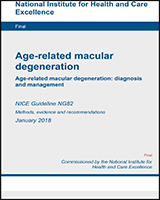NCBI Bookshelf. A service of the National Library of Medicine, National Institutes of Health.
Age-related macular degeneration: diagnosis and management. London: National Institute for Health and Care Excellence (NICE); 2018 Jan. (NICE Guideline, No. 82.)
E.1.1. Classification
RQ6: What effective classification tool should be used to classify different types of AMD?
Download PDF (1.0M)
E.2. Risk factors
E.2.1. Risk factors for development or progression of AMD
RQ2: What risk factors increase the likelihood of a person developing AMD or progressing to late AMD?
Download PDF (1.9M)
E.2.2. Strategies to slow the progression of age-related macular degeneration (AMD)
RQ7: What is the effectiveness of strategies to reduce the risk of developing AMD in the unaffected eye or slow the progression of AMD?
The evidence tables in this section were produced by the Cochrane Eyes and Vision group, as part of a collaboration with the NICE Internal Clinical Guidelines Team.
Download PDF (1.2M)
E.3. Diagnosis
E.3.1. Signs and symptoms of AMD
RQ1: What signs and symptoms should prompt a healthcare professional to suspect AMD in people presenting to healthcare services?
Download PDF (230K)
E.3.2. Tools for triage, diagnosis and informed treatment
RQ4: What tools are useful for triage, diagnosis, informing treatment and determining management in people with suspected AMD?
Download PDF (1.0M)
E.4. Referral
E.4.1. Organisational models and referral pathways for triage, diagnosis, ongoing treatment and follow-up people with suspected and confirmed AMD
RQ5: How do different organisational models and referral pathways for triage, diagnosis, ongoing treatment and follow up influence outcomes for people with suspected AMD (for example correct diagnosis, errors in diagnosis, delays in diagnosis, process outcomes)?
RQ16: How do different organisational models for ongoing treatment and follow up influence outcomes for people with diagnosed neovascular AMD (for example disease progression, time to treatment, non-attendance)?
RQ 24: How soon should people with neovascular AMD be diagnosed and treated after becoming symptomatic?
Download PDF (1.0M)
E.5. Non-pharmacological management
E.5.1. Psychological therapies
RQ8: What is the effectiveness of psychological therapies for AMD?
Download PDF (633K)
E.5.2. The effectiveness of support strategies for people with impairment and age-related macular degeneration (AMD)
RQ9: What is the effectiveness of support strategies for people with visual impairment and AMD (for example reablement services and strategies for optimising existing visual performance)?
Download PDF (702K)
E.6. Pharmacological management
E.6.1. Anti-angiogentic therapies for the treatment of late AMD (wet active)
RQ12: What is the effectiveness of different anti-angiogenic therapies (including photodynamic therapy) for the treatment of late AMD (wet active)?
RQ18: What is the effectiveness of different frequencies of administration of antiangiogenic therapies for the treatment of late AMD (wet active)?
The evidence tables in this section were produced by the Cochrane Eyes and Vision group, as part of a collaboration with the NICE Internal Clinical Guidelines Team.
Download PDF (2.9M)
E.6.2. Anti-VEGF treatment in people presenting with visual acuity better than 6/12 or worse than 6/96
RQ10: What is the effectiveness of treatment of neovascular AMD in people presenting with visual acuity better than 6/12?
RQ25: What is the effectiveness of treatment of neovascular AMD in people presenting with visual acuity worse than 6/96?
Download PDF (887K)
E.6.3. Adjunctive therapies
RQ13: What is the effectiveness of adjunctive therapies for the treatment of late AMD (wet active)?
Download PDF (1.5M)
E.6.4. Switching and stopping antiangiogenic treatment for late AMD (wet)
RQ11: What are the indicators for treatment failing and switching?
RQ14: What factors indicate that treatment for neovascular AMD should be stopped?
RQ15: What is the effectiveness of switching therapies for neovascular AMD if the first-line therapy is contraindicated or has failed?
The evidence tables in this section were produced by the National Guideline Centre.
Download PDF (1.4M)
E.6.4.1. Agree II critical appraisal for the review of factors for treatment switching or stopping
Download PDF (366K)
E.7. Monitoring
E.7.1. Frequency of monitoring
Frequency of review
RQ19: How often should people with early age-related macular degeneration (AMD), indeterminate AMD, or advanced geographic atrophy be reviewed?
RQ20: How often should people with early AMD, indeterminate AMD, or advanced geographic atrophy have their non-affected eye reviewed?
RQ21: In people with neovascular AMD who are not being actively treated, how often should they be reviewed?
RQ22: How often should people with neovascular AMD have their non-affected eye reviewed?
No studies were identified for these review questions.
E.7.2. Self monitoring
RQ23a: What strategies and tools are useful for self-monitoring for people with AMD?
Download PDF (319K)
E.7.3. Monitoring strategies and tools for people with late age-related macular degeneration (wet active)
RQ23b: What strategies and tools are useful for monitoring for people with late AMD (wet active)?
Download PDF (770K)
E.8. Information
E.8.1. Barriers and facilitators to appointment attendance and update of treatment for people with age-related macular degeneration
RQ17: What are the barriers and facilitators to appointment attendance and uptake of treatment for people with AMD?
Download PDF (507K)
E.8.2. Informational needs of people with suspected or confirmed AMD and their family members/carers
RQ3a: What information do people with suspected AMD and their family members or carers find useful, and in what format and when?
RQ3b: What information do people with confirmed AMD and their family members or carers find useful, and in what format and when?
Download PDF (315K)
- Evidence tables - Age-related macular degenerationEvidence tables - Age-related macular degeneration
Your browsing activity is empty.
Activity recording is turned off.
See more...
